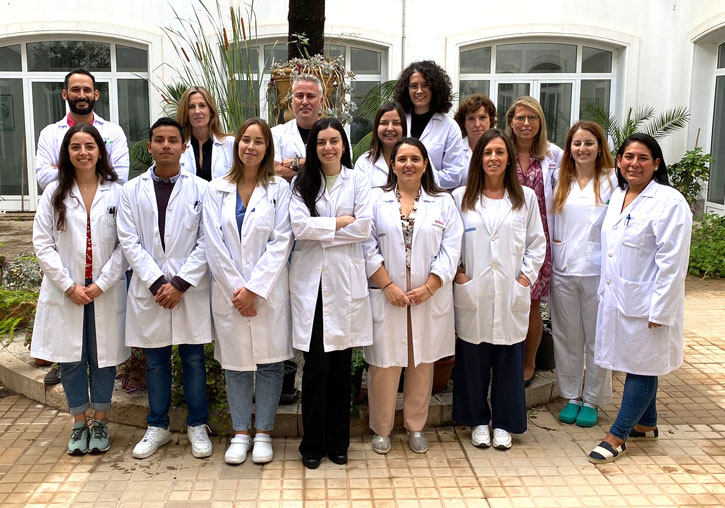Evaluated the antioxidant and anti-inflammatory actions of gold and cerium nanoparticles in patients with type 2 diabetes
- Scientific Culture and Innovation Unit
- January 19th, 2023

A study by the University of Valencia, the INCLIVA Health Research Institute, the Clinical Hospital of Valencia, Fisabio-Hospital Dr. Peset and the Polytechnic University of Valencia (UPV) shows that gold and cerium Au/CeO2 nanoparticles with a gold content of only 0.82%, they exert antioxidant and anti-inflammatory actions in the leukocyte-endothelium interaction of patients with type 2 diabetes (DM2). In this way, a protective role is created against the appearance of atherosclerosis and cardiovascular diseases.
Leukocyte-endothelium interactions are a series of processes that occur when leukocytes, also known as white blood cells, move through the endothelial layer that lines blood vessels in search of sites of inflammation or infection. These interactions are an essential part of the immune system and play an important role in protecting the body against infection and disease.
The aim of this study was to evaluate the effects of gold and cerium Au/CeO2 nanoparticles with different degrees of gold purity (10, 4.4, 1.79 and 0.82%) on leukocyte-endothelium interactions and the inflammation in patients with DM2. Its principal investigator is Víctor Manuel Víctor González, from the INCLIVA Vascular Function Research Group (coordinated by José Mª Vila Salinas), and from the Molecular Mechanisms Underlying Diabesity Group, from Fisabio-Hospital Dr. Peset.
The first results of this research have recently been published in the journal Antioxidants. The prospective and observational study was carried out in a cohort of 57 patients with DM2 – treated at the Endocrinology Service of the Doctor Peset University Hospital in Valencia and diagnosed according to the criteria of the American Diabetes Association – and 51 healthy people.
Participating in the study were, among others, Susana Rovira-Llopis (UV); Hermenegildo García (Institute of Chemical Technology-ITQ) of the UPV; and Pedro Díaz Pozo and Milagros Rocha Barajas, both from Fisabio-Hospital Dr. Peset. The research staff that have participated are linked to the Centre for Online Biomedical Research in Hepatic and Digestive Diseases (CIBEREHD) and the Centre for Online Biomedical Research in Bioengineering, Biomaterials and Nanomedicine (CIBERBBN).
DM2 is a serious health problem throughout the world, since its prevalence is increasing and implies a reduction in life expectancy. Oxidative stress – which occurs when there is an imbalance between the production of free radicals and the body’s ability to fight them with antioxidants, leads to health problems such as premature aging, heart disease, certain types of cancer and other chronic diseases – and Mitochondrial deterioration have been related to the appearance of insulin resistance, DM2 and cardiometabolic diseases.
The use of nanoparticles in biomedicine is growing, with a variety of potential applications, including antioxidant therapy, bioimaging, and drug delivery. Among the different types of nanoparticles, cerium (CeO2) nanoparticles are especially promising due to their versatility, biocompatibility, and physicochemical properties.
Additionally, CeO2 has been shown to have antioxidant properties and can be used to combat oxidative stress. This antioxidant capacity can be increased when the nanoparticles are combined with certain metals, such as silver, platinum, or gold. To achieve maximum antioxidant activity, gold nanoparticles need to have a diameter of a few nanometres, with a narrow size distribution, and to be stable against agglomeration. This is achieved by properly depositing the gold particles on the surface of the cerium oxide that acts as a support. For this reason, the work is multidisciplinary and requires a team with the capacity to prepare this type of material such as the ITQ.
Although the etiology of insulin resistance and DM2 is complex, different studies supported the potential of gold nanoparticles as antioxidants in models of DM2, among others, but whether they could provide benefits to those suffering from this disease was still unknown.
The research has obtained funding of 207,157 euros from the Valencian Government (PROMETEO/2019/027) and 183,920 euros from the Carlos III Health Institute (PI19/0838).
Article: Díaz-Pozo P., Canet F., Grirrane A., López-Doménech S., Herance J. R., Apostolova N., Luna-Marco C., Rovira-Llopis S., Martí M., Morillas C., Rocha M., García H., Víctor V. M. «Gold Nanoparticles Supported on Ceria Nanoparticles Modulate Leukocyte-Endothelium Cell Interactions and Inflammation in Type 2 Diabetes». Antioxidants (Basel). 2022 Nov 20;11(11):2297. doi: 10.3390/antiox11112297. PMID: 36421483; PMCID: PMC9686981. Link: https://pubmed.ncbi.nlm.nih.gov/36421483/
















